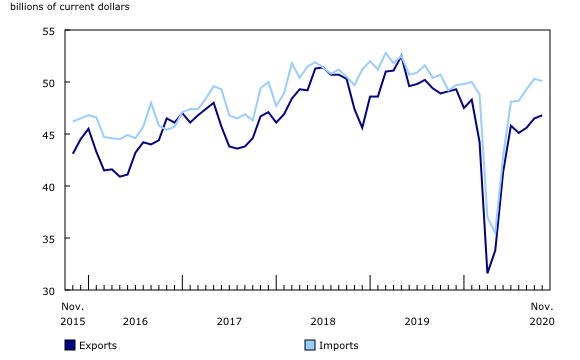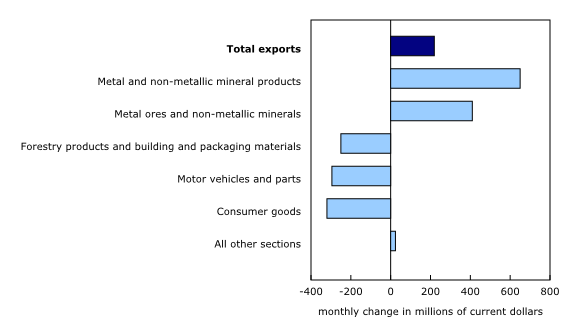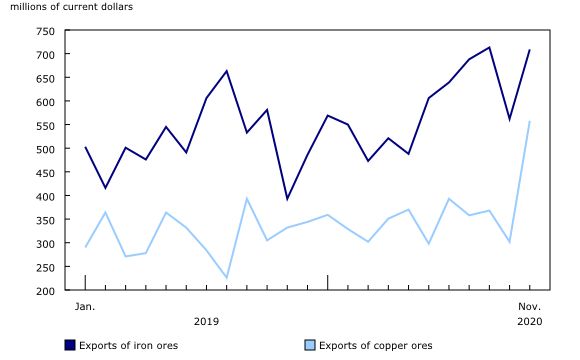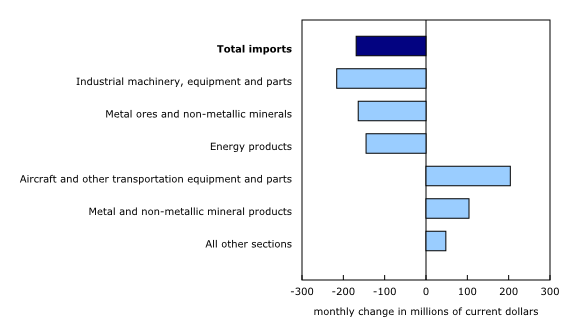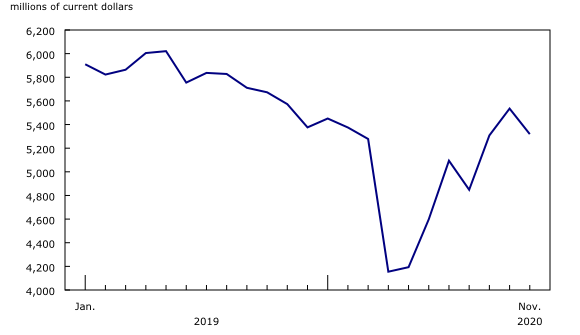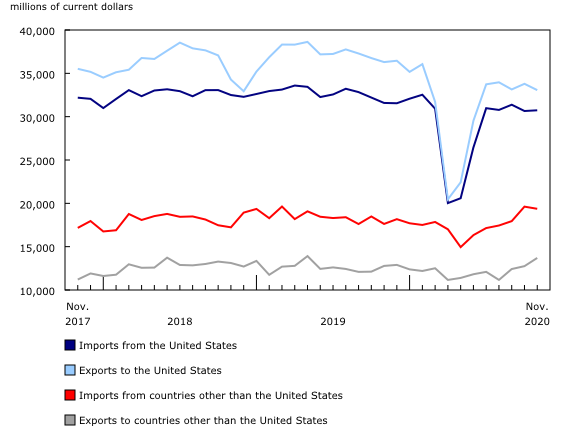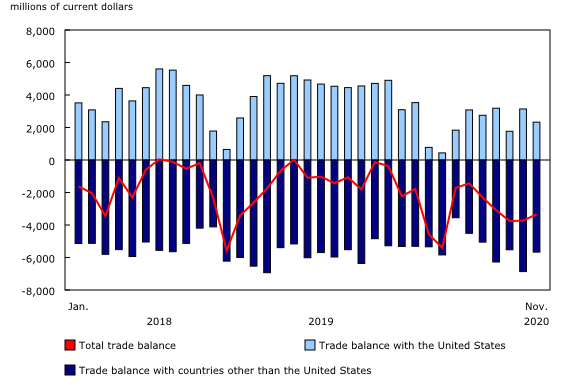Canadian international merchandise trade, November 2020
Archived Content
Information identified as archived is provided for reference, research or recordkeeping purposes. It is not subject to the Government of Canada Web Standards and has not been altered or updated since it was archived. Please "contact us" to request a format other than those available.
Released: 2021-01-07
In November, Canada's merchandise exports increased 0.5%, with gold exports posting the largest increase. Imports edged down 0.3%, on lower imports of industrial machinery, equipment and parts. As a result, Canada's merchandise trade deficit with the world narrowed from $3.7 billion in October, to $3.3 billion in November.
Following a number of significant increases and decreases earlier in the year, the rate of change in Canada's trade activity slowed in November, with total trade edging up 0.1%. This represented the smallest monthly percentage change in 2020.
To explore the most recent results from Canada's international merchandise trade in an interactive format, see the "International merchandise trade monthly interactive dashboard."
Exports of gold to the United Kingdom surge
Total exports were up 0.5% in November to $46.8 billion—$1.5 billion below the pre-COVID-19-pandemic mark set in February. Despite this growth, 7 out of 11 product sections posted declines. Non-energy exports increased 0.2% to $39.9 billion, $129 million shy of their February levels. In real (or volume) terms, total exports rose 0.9%.
Exports of metal and non-metallic mineral products increased 11.6% in November, mainly on higher exports of unwrought gold, silver and platinum group metals, and their alloys (+25.8%). Increased exports of refined gold to the United Kingdom were behind this surge, resulting from a rise in sales of cast gold bullion bars, as well as higher transfers of gold within the banking system.
Exports of metal ores and non-metallic minerals (+26.0%) also rose significantly in November. Increases in exports of copper ores (+84.6%) and iron ores (+26.0%) both contributed strongly to the growth in this product section. Despite the pandemic, market conditions (rising prices, strong foreign demand, and supply issues in other countries) have been advantageous for Canadian producers of copper and iron ores in 2020. These factors contributed to an atypical increase in exports of these commodities in November. So far in 2020, exports of both copper and iron ores have already surpassed their 2019 totals.
These increases were offset in part by lower exports of motor vehicles and parts (-4.1%). After a 7.2% decrease in October, exports of passenger cars and light trucks (-4.0%) fell again in November. Exports of engines and parts (-4.4%) were also down, coinciding with lower motor vehicle production in the United States.
Exports of forestry products and building and packaging materials (-6.2%) also declined in November. This was primarily the result of lower exports of lumber (-11.6%), which were down mainly on lower prices. After months of rising prices that peaked in September, lumber prices stabilized in October and then decreased in November. However, these prices remained significantly higher in November compared with May, when the increase began.
Following two months of growth, imports of industrial machinery fall
Total imports decreased 0.3% in November to $50.1 billion, which was still above pre-pandemic levels. This was the first decline after five consecutive months of growth. In real (or volume) terms, imports were down 0.7%.
Imports of industrial machinery, equipment and parts decreased 3.9% in November to $5.3 billion—the second decline in seven months. Since the 21.3% decrease in April, imports of industrial machinery and equipment have increased 28.0%. The decrease in imports of other general-purpose machinery and equipment (-6.8%) contributed the most to the decline this month. In October, high-value shipments of wind turbines from China related to a new wind farm project were observed. These shipments were not repeated in November.
Imports of metal ores and non-metallic minerals decreased 11.0% in November. Despite the monthly decline, imports of this product section were already up by 5.9% in 2020 compared with the full year of 2019. Both the monthly decrease and annual growth were attributable primarily to imports of other metal ores and concentrates—a category composed largely of gold for refining purposes. This month's decrease in imports of other metal ores and concentrates (-23.2%) was mainly the result of lower imports of gold from Peru.
These decreases were partially offset by higher imports of aircraft and other transportation equipment and parts (+16.2%). Imports of aircraft led the increase, in part because of two new airliners imported from Ireland. Imports of aircraft have been affected heavily by the pandemic. So far in 2020, the value of these imports has decreased 39.0% compared with the same period in 2019—a year affected by supply issues resulting from the grounding of some airliners.
Exports to non-US countries reach a record on higher exports of gold
The divergent trend between Canada's trade with the United States versus Canada's trade with other countries continued in November. Total trade with countries other than the United States was up 2.1% in November, reaching a record $33.1 billion. Total trade with the United States decreased 1.0% to $63.8 billion—the lowest level since June. While total trade with countries other than the United States was up $3.4 billion in November compared with February, total trade with the United States was $4.8 billion below the levels observed that month. A significant part of that gap is the result of lower exports and imports of energy products.
In November, exports to countries other than the United States rose 7.4%, a sixth increase in the last seven months. The United Kingdom was by far the largest contributor to the growth in Canada's exports to non-US countries—the result of higher exports of refined gold. Imports from countries other than the United States were down 1.3% in November. Imports from Peru, South Korea and Germany saw the largest decreases. After reaching a record high in October, imports from China remained high, despite falling 2.1% on lower imports of wind turbines. Canada's trade deficit with countries other than the United States narrowed from $6.9 billion in October to $5.7 billion in November.
Exports to the United States fell 2.2% in November, while imports edged up 0.3%. As a result, Canada's trade surplus with the United States narrowed from $3.1 billion in October to $2.3 billion in November.
When the average exchange rates of October and November are compared, the Canadian dollar gained 0.8 cents US relative to the American dollar, reaching its highest level (76.5 cents US) since October 2018.
Revisions to October merchandise exports and imports data
Imports in October, originally reported as $50.2 billion in the previous release, were revised to $50.3 billion in the current month's release. Exports in October, originally reported at $46.5 billion in the previous release, were essentially unchanged in the current month's release.
Trade in medical and protective goods
Following two consecutive monthly declines, imports of medical and protective goods increased 6.7% in November to $3.3 billion on a customs basis. Higher imports of diagnostic products (+35.4%) and medical equipment and products (+8.8%) were moderated by lower imports of personal protective equipment (-8.9%) and disinfectant and sterilization products (-14.8%). Year over year, imports of medical and protective goods were up 46.3%. Meanwhile, exports of medical and protective goods decreased 8.3% to $1.4 billion in November because of lower exports of medical equipment and products (-8.9%). Much of the monthly fluctuation in imports of diagnostic products, as well as imports and exports of medical equipment and products, resulted from variations in trade unrelated to COVID-19.
Monthly trade in services
In November, monthly service exports were up 1.0% to $9.4 billion, and service imports edged down 0.1% to $9.3 billion.
When international trade in goods and services are combined, exports increased 0.6% to $56.2 billion in November, while imports fell 0.3% to $59.4 billion. As a result, Canada's trade deficit with the world for goods and services combined was $3.2 billion in November.
Note to readers
Merchandise trade is one component of Canada's international balance of payments (BOP), which also includes trade in services, investment income, current transfers, and capital and financial flows.
International trade data by commodity are available on both a BOP and customs basis. International trade data by country are available on a customs basis for all countries, and on a BOP basis for Canada's 27 principal trading partners (PTPs). The list of PTPs is based on their annual share of total merchandise trade—imports and exports—with Canada in 2012. BOP data are derived from customs data by adjusting for factors such as valuation, coverage, timing and residency. These adjustments are made to conform to the concepts and definitions of the Canadian System of National Accounts.
For a conceptual analysis of BOP-based data versus customs-based data, see "Balance of Payments trade in goods at Statistics Canada: Expanding geographic detail to 27 principal trading partners."
For more information on these and other macroeconomic concepts, see the Methodological Guide: Canadian System of Macroeconomic Accounts (13-607-X) and the User Guide: Canadian System of Macroeconomic Accounts (13-606-G).
The data in this release are on a BOP basis and are seasonally adjusted. Unless otherwise stated, values are expressed in nominal terms, or current dollars. References to prices are based on aggregate Paasche (current-weighted) price indexes (2012=100). Movements within aggregate Paasche prices can be influenced by changes in the share of values traded for specific goods, with sudden shifts in trading patterns—as observed currently with the pandemic—sometimes resulting in large movements in Paasche price indexes. Volumes, or constant dollars, are calculated using the Laspeyres formula (2012=100), unless otherwise stated.
For information on seasonal adjustment, see Seasonally adjusted data – Frequently asked questions.
Revisions
In general, merchandise trade data are revised on an ongoing basis for each month of the current year. Current-year revisions are reflected in both the customs-based and BOP-based data.
The previous year's customs-based data are revised with the release of data for the January and February reference months, and thereafter on a quarterly basis. The previous two years of customs-based data are revised annually, and revisions are released in February with the December reference month.
The previous year's BOP-based data are revised with the release of data for the January, February, March and April reference months. To remain consistent with the Canadian System of Macroeconomic Accounts, revisions to BOP-based data for previous years are released annually in December with the October reference month.
Factors influencing revisions include the late receipt of import and export documentation, incorrect information on customs forms, the replacement of estimates produced for the energy section with actual figures, changes in merchandise classification based on more current information, and changes to seasonal adjustment factors.
For information on data revisions for exports of energy products, see Methodology for Exports of Energy Products within the International Merchandise Trade Program.
Revised data are available in the appropriate tables.
Real-time data table
The real-time data table 12-10-0120-01 will be updated on January 18.
Next release
Data on Canadian international merchandise trade for December 2020 will be released on February 5, 2021.
Products
The product International merchandise trade monthly interactive dashboard (71-607-X) is now available. This new interactive dashboard is a comprehensive analytical tool that presents monthly changes in Canada's international merchandise trade data on a balance of payments basis, fully supporting the information presented every month in the Daily text.
The product The International Trade Explorer (71-607-X) is now available online.
Customs-based data are now available in the Canadian International Merchandise Trade Database (65F0013X).
The updated Canada and the World Statistics Hub (13-609-X) is now available online. This product illustrates the nature and extent of Canada's economic and financial relationship with the world using interactive graphs and tables. This product provides easy access to information on trade, investment, employment and travel between Canada and a number of countries, including the United States, the United Kingdom, Mexico, China, Japan, Belgium, Italy, the Netherlands and Spain.
Contact information
For more information, contact us (toll-free 1-800-263-1136; 514-283-8300; STATCAN.infostats-infostats.STATCAN@canada.ca).
To enquire about the concepts, methods or data quality of this release, contact Benoît Carrière (613-415-5305; benoit.carriere@canada.ca), International Accounts and Trade Division.
- Date modified:




